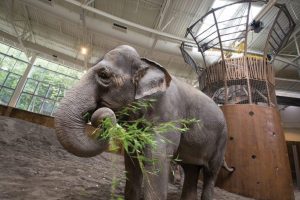One day, I learned that our firm had been awarded the Oregon Zoo Elephant Lands project, a new 6-acre development to replace the existing, old exhibit that housed a herd of seven Asian elephants. Suddenly, the reality of having to design structures to withstand abuse from elephants standing 14 feet tall and weighing 14,000 pounds settled in. Not finding “Elephants” listed in Table 4-1 of ASCE 7-10, it became quickly apparent that this was not going to be like any other project I had designed. As it turned out, the elephants repeatedly reminded me of many great things about our profession, lessons that serve to inspire me at work to this day.
 Elephant Lesson No.1: Structural Engineering is a CREATIVE Profession
Elephant Lesson No.1: Structural Engineering is a CREATIVE Profession
It is sometimes easier and more profitable for us to design in cruise control but, for the future of our profession, we must continually strive to build creativity and innovation into our designs. Overly prescriptive building codes and limited construction budgets can lull us into allowing our designs to draw from a very small box of conventional solutions and standard details. Creativity is often limited to the selection of the optimal lateral force resisting system, offering input on the building grid or, at its most mundane, selection of the perfect post-installed anchor. For me, it took one look at Packy, one of the largest Asian elephants in captivity at the time, to realize that I was going to have to put on my creative hat. Armed with my knowledge and experience, I was able to design barrier fencing, shade shelters, interactive elements, and buildings that could survive any loading scenario Packy could create, while protecting animal welfare, meeting the architect’s aesthetic requirements, and allowing for an enhanced visitor experience. Packy precluded me from hiding behind the code and inspired me to think outside the box. Demonstrating creativity is the key to elevating the status of the Structural Engineer in the design process.
Elephant Lesson No.2: Get to Know End Users
As structural engineers, we can add more value to the design process by involving ourselves in early discussions with end users of the buildings we design. On building projects, the Architect is typically responsible for determining the needs and desires of the end users or owners and crafting their design to meet those needs and desires. Packy and his herd taught me that the structural engineer could and should have more relevance in this discussion. People are inside buildings for most of their lives; they would benefit from understanding what those buildings are made of and how they are expected to perform. In the case of Elephant Lands, the entire structural design was driven by the behavioral characteristics of the elephants. Zookeepers provided anecdotal information on what worked and did not work in the old habitat, and we spent hours observing the elephants, making refinements to our design as we learned more about them. The result speaks for itself, as the zookeepers and elephants are happier and safer than ever before. We need to push past resistance and insert ourselves early in the process to ensure that our designs are effective at meeting the users’ needs.
Elephant Lesson No.3: Projects are Teaching Opportunities
How often do you receive a call like this: “I have this project, and I was told I need an engineer to stamp it. Do you do that?” There are signs that our profession is trending toward commoditization, and one contributing factor is a lack of knowledge of what structural engineers do. Much of the spotlight on the Elephant Lands project was focused on the integrity of the structural design. Consequently, there were many opportunities for us to explain to non-engineers how and why we arrived at our engineering solutions. The display of genuine interest in what we do made me realize that, as practicing engineers, we must be willing to take the time to explain how great and essential our profession is, and to capitalize on opportunities to do so. When the head elephant keeper introduces me as “Packy’s structural engineer,” another of these opportunities presents itself. Then it’s show time!
Elephant Lesson No.4: We Make the World a Safer Place
It is relatively easy to get lost in our analysis and problem solving and forget about the impact our work has on the world around us. It took witnessing the elephants being introduced to their new facility for me to remember this. In their old facility, the elephants were confined to a relatively small space; I was accustomed to seeing them looking bored and lazy. When the massive door to the new outdoor habitat opened, the herd bounded out and began exploring with vigor. According to the keepers, the elephants have never been healthier and they attribute that to the design of the new facility. Being in a safe place designed just for them, they are flourishing. As structural engineers, we make this happen every day. Whether we are establishing, restoring, or enhancing the safety of structures, we make the world a safer place every day we show up to work. We must not lose sight of this; it is our primary directive as structural engineers.
Parting Elephant Epiphany
Innovative structural designs and creative problem solving require some level of inspiration. In today’s workplace, it is difficult to find this inspiration amidst the noise of endless emails, compressed schedules, and everchanging code requirements. It may not be there on every project but, when you find it, capitalize on it and show everyone what you can do. I continue to draw inspiration from the elephants that I met a few years ago. Here’s to you finding your own Packy soon!■
